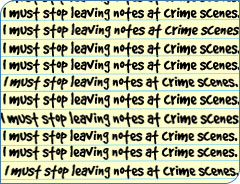 CHARACTER ANALYSIS
CHARACTER ANALYSIS
 Do your unrelenting angular formations combined with heavy pressure and excessive forward slant set you apart from the crowd? Do you possess restrictions, left-tending strokes, redrawn strokes and many angles? Have no idea what we're talking about? It's all to do with writing, and what sets your penmanship apart from others.
Do your unrelenting angular formations combined with heavy pressure and excessive forward slant set you apart from the crowd? Do you possess restrictions, left-tending strokes, redrawn strokes and many angles? Have no idea what we're talking about? It's all to do with writing, and what sets your penmanship apart from others.
For criminals silly enough to leave a note behind at the scene of the crime, deciphering the text and identifying the author will one day become as routine and accurate as fingerprinting.
The technology is the product of research from the US University of Buffalo. The Centre for Document Analysis and Recognition (CEDAR), originally designed the software program to help the US postal system in identifying addresses on envelopes.
However, now instead of merely identifying addresses on letters, the software has been modified to identify differences between samples of writing. The technology is accurate 98 percent of the time, say the creators.
Currently in criminal cases, the question of who wrote a ransom note, or forged a cheque is solved by human handwriting analysts. However, because they are human, even the best graphologists cannot always be 100 percent objective and therefore accurate. The new software is the first that can identify who wrote a particular document based on purely scientific criteria.
"A human expert may put in his or her own bias even unconsciously. We have built the foundation for a handwriting analysis system that will quantify performance and increase confidence in determining a writer's identity," says Sagur Srihari of CEDAR.
It is the first time that researchers have analysed writing based on a large database of hand writing, and by using a totally automated means of measuring the specifics of penmanship.
 Note taken?
Note taken?
"This is about validating individuality in handwriting. The idea that everyone's handwriting is different is taken for granted. What we have done is to develop purely scientific criteria for that premise," says Srihari.
Providing this scientific basis for establishing the identity of the person who scribbled a note has become essential for admitting handwriting evidence in US courts.
"In this project we are developing a technology whose job it is to authenticate documents," says Srihari.
The UB researchers developed the software by first collecting a database of more than 1,000 samples of handwriting from a pool of individuals representing a microcosm of the US population in terms of gender, age and ethnicity. A number of samples of handwriting were taken from the subjects, who were asked to write the same series of documents in cursive.
Instead of analysing the documents visually, in the manner a human expert normally would, the researchers deconstructed every sample by extracting features from the writing, such as measuring the shapes of the individual characters, descenders and the spaces between lines and words.
The researchers then ran the samples through their software program.
"We tested the program by asking it to determine which of the two authors wrote a particular sample, based on measurable features. The program responded correctly 98 percent of the time," says Srihari.
It is customary for human experts to look for arcades and garlands and other features that may determine one person's penmanship from another's. The software should be able to do this within a year, making it even more accurate explains Srihari.
So, if you're the type of person that writes ransom notes often, just mind your P's and Q's, and your decenders and arcades as well...
